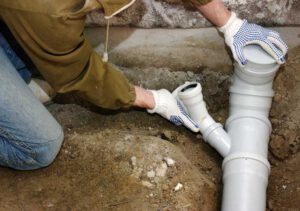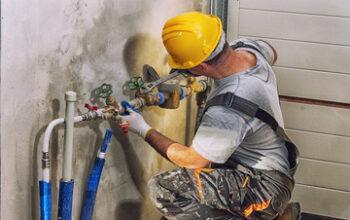Over time, sewer pipes can corrode or become damaged. The constant flow of sewage can wear down the line and create cracks or holes.

Fortunately, there are several ways to repair your sewer lines. These methods are quicker and tidier than traditional excavation. Visit Website to learn more.
A professional can use a video inspection to determine the damage and recommend the best repair method.
Pipe lining is one of the most popular methods for repairing and replacing sewer lines. It involves coating the inside of a pipe with a new liner, which will resist corrosion and prevent leaks. This method is a good option for those who want to avoid the cost of digging and replacing their entire sewer system. It is also a good choice for those who have small, shallow pipes that are damaged by tree roots.
The process of pipe lining is fast, easy, and less invasive than traditional sewer repair methods. It requires only a few days to complete the job, and it can be done without affecting your home or business. However, there are some things to consider before deciding on this method. First, you should make sure that your sewer pipe is in need of repair. Some signs of a damaged sewer line include slow or clogged drains, sewage backups, and foul odors. If you notice any of these symptoms, it is a good idea to call a plumber for a professional inspection.
A sewer relining technician will clean the piping and remove any obstructions before installing the liner. A rubber bladder is then inserted into the pipe and inflated with air pressure. It is then exposed to heat or UV light to cure the epoxy resin. Once the liner is fully cured, it is removed, and the pipe is back in service.
CIPP liners are suitable for both short and long runs of pipes that do not require upsizing. They can be used on pipes made of cast iron, clay tile, ABS plastic, PVC, and copper. This method is also useful for repairing cracked, worn, or broken pipes. It can even fix a leaking sewer main, which is often the source of water and sewage leaks in homes.
While relining is an excellent solution for many problems, it may not work in every situation. For example, if your sewer pipe has a sharp bend, the lining process will likely fail. This can cause wrinkling in the liner, which will increase friction and prevent waste from flowing freely. In addition, if your pipes are very old or heavily damaged, the lining may not last very long.
Pipe bursting
Pipe bursting is one of the most popular trenchless sewer repair options. This process uses hydraulics to pull new pipes through existing ones, resulting in the old ones being broken apart and pushed out into the surrounding soil. It’s a great option for homeowners who want to replace their old, corroded pipes or upgrade to a larger pipe size. The benefits of this method include reduced maintenance costs, improved water flow, and increased property value.
The first step of the pipe-bursting process is to prepare the site. This includes digging a pit for the new pipe’s launch location as well as clearing the area around the damaged pipe. Then, the bursting head is installed and connected to a new line of pipe. This head is a cone-shaped device that breaks up the old pipe while pulling new pipe through. The bursting head is connected to a new piece of seamless, heat-fused HDPE pipe. It can even replace cast-iron pipes!
This method is much safer than traditional excavation methods, as it minimizes the chances of people getting stuck in a trench. Plus, it’s less prone to damage and can be done without the need for city permits or lengthy excavation processes. It’s also less likely to cause accidents or injuries.
It’s important to keep in mind that not all situations can be addressed with this type of trenchless technology. This is especially true if the existing pipes are too badly damaged to be repaired with this technique. In such cases, the only option may be to dig up the pipes using traditional methods.
While it’s not ideal, you can do some things to reduce the wait time for your plumber after a burst pipe occurs. The best thing to do is call a professional right away so that they can get to the job as soon as possible. It’s also important to keep doors open throughout the house so that air can circulate and help dry out any affected areas.
Another way to shorten the waiting time is to use a repair sleeve while you wait for your plumber. This is a cheap and temporary solution that will keep your home functional until the professionals arrive. However, it’s important to remember that this fix won’t work in the long run, and you will need to have the damaged pipes replaced.
Pipe cleaning
The system of sewer pipes is complex and often out of sight, making it difficult to know when something goes wrong. Signs that your sewage line is damaged or clogged include gurgling sounds from drains, toilets that don’t flush properly, and water that backs up into sinks, tubs, and showers.
If you experience any of these problems, it’s important to contact a plumber right away. They can diagnose the issue and determine the best solution for your home. Most importantly, a professional can help you avoid costly sewer repairs by performing regular maintenance on your sewer lines.
A common cause of clogged or damaged sewer lines is tree roots. They can break or puncture the pipes, leading to sewage backups and other serious problems. To prevent this, a professional can use a camera to inspect the line and find out what is causing the problem. They can then take the necessary steps to repair or replace it.
During a pipe cleaning, the plumber uses a high-pressure hose to blast away debris that has accumulated in the pipes. This is a trenchless method of sewer line repair that can be used on PVC, cast-iron, and clay pipes. The process also removes root growth, so you won’t have to worry about future blockages.
A thorough inspection will also let the plumber know if there are any other issues with your sewer line, such as leaks or corrosion. They can then recommend the appropriate repair method.
Many homeowners don’t give their sewer lines much thought until they stop working or smell bad. The health of your sewer line is crucial to the safety of your family. Sewage water contains harmful bacteria, parasites, and fungi that can lead to a variety of health problems. Exposure to sewage waste can even cause sickness in your family members. If you notice signs of a damaged or clogged sewer line, contact a plumber immediately.
A plumber can perform several different types of repairs on your sewer line. They may recommend excavation, pipe bursting, or sewer line cleaning, depending on the condition of your pipes and the severity of the damage. In addition, they can advise you on how to minimize problems with your sewer lines in the future by implementing preventative maintenance.
Drain cleaning
The term “drain cleaner” refers to a person, product, or device that unblocks sewer pipes or clogged wastewater drains. Typically, these products include commercial chemical products and mechanical utensils such as plungers, handheld drain augers, and electric drain cleaners. Depending on the type of drain cleaner, these products can either remove soft obstructions like hair or grease that accumulate near a single fixture’s drain inlet or they can clear blockages further down in the plumbing piping system, such as the main building drains and lateral drain lines to the collector sewer mains.
It’s important to get your drains cleaned regularly as part of preventative maintenance for your home. A sewer backup can be extremely costly and a major hassle for your family. It can also cause significant damage to your property and affect the health of your family. Regular drain cleaning can help avoid serious clogs and keep your sewer line healthy for a longer period of time.
There are several things that can clog your drains and sewer lines, including food waste, cooking oil, hair, non-flushable items that are flushed down toilets (such as wipes and sanitary products), and roots from trees that invade underground drains and sewer lines in search of water. When these items build up in your drains and sewer lines, they can cause blockages that will require professional drain cleaning to resolve.
If you’re experiencing slow-draining sinks, gurgling sounds when flushing toilets, or a sewer-like smell in your home, it’s time to call a plumber for drain cleaning. A clogged drain can lead to serious problems such as flooding, water and sewage back-up, and damaged pipes. These problems can be much more expensive and dangerous to fix than a simple drain clog.
It’s important to never try a DIY solution for clogged drains or sewer issues, as this can cause more damage and put your safety at risk. Only qualified, licensed, and insured plumbers should work on your pipes and sewer lines. Never park vehicles or heavy equipment on or near your drain field, septic tank, or sewage line, as this can compact the soil and damage the lines.

